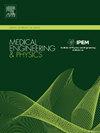一种新型3D轻量化模型用于COVID-19肺部CT病灶分割
IF 2.3
4区 医学
Q3 ENGINEERING, BIOMEDICAL
引用次数: 0
摘要
与基于二维切片的方法相比,基于3d的医学图像分割提供了增强的空间信息,但由于临床样本量有限、前景-背景像素分布不平衡以及泛化性能欠佳等因素,面临着挑战。为了解决这些挑战,我们提出了一种适合3D医学图像的轻量级分割模型。该方法采用K-means算法,有效地从医学图像中提取感兴趣区域(ROI),促进肺区域分割,同时最大限度地减少背景像素的干扰。我们通过采用Focal loss和Dice系数作为损失函数来解决模型过拟合的风险。通过在跳跃连接中加入并行注意机制,增强了特征提取能力,旨在增强浅层和深层的表示。此外,我们通过用深度可分离卷积代替3 × 3卷积和积分残差连接来优化计算效率和内存利用率,以改进梯度传播。引入幽灵启发的1 × 1卷积确保残差连接前后的特征维度一致。在包含199例COVID-19-Seg病例的数据集上进行了5倍交叉验证的实验评估,强调了我们提出的模型的优越性能。评估指标包括平均表面距离(ASD)、准确度、灵敏度、Dice系数和交汇交汇(IOU)准确度,良率分别为19.880、99.90%、58.90%、56.10%和41.00%。与其他最先进的分割模型相比,我们的方法实现了更高的分割精度和泛化性能,同时只引起参数和计算复杂性的边际增加。本文章由计算机程序翻译,如有差异,请以英文原文为准。
A novel 3D lightweight model for COVID-19 lung CT Lesion Segmentation
3D-based medical image segmentation, offering enhanced spatial information compared to 2D slice-based methods, encounters challenges arising from factors such as a restricted clinical sample size, imbalanced foreground-background pixel distribution, and suboptimal generalization performance. To address these challenges, we propose a lightweight segmentation model tailored to 3D medical images. Employing the K-means algorithm, our approach efficiently extracts the Region of Interest (ROI) from medical images, facilitating lung area segmentation while minimizing interference from background pixels. We address the risk of model overfitting by adopting the Focal loss in conjunction with the Dice coefficient as our loss function. Feature extraction capabilities are bolstered through the incorporation of a parallel attention mechanism at skip connections, aiming to enhance the representation of both shallow and deep layers. Moreover, we optimize computational efficiency and memory utilization by substituting 3 × 3 convolutions with depth-wise separable convolutions and integrating residual connections for improved gradient propagation. The introduction of Ghost-inspired 1 × 1 convolution ensures consistent feature dimensions before and after residual connections. Experimental evaluation, conducted on a dataset comprising 199 COVID-19-Seg cases through 5-fold cross-validation, underscores the superior performance of our proposed model. Evaluation metrics, including Average Surface Distance (ASD), accuracy, sensitivity, Dice coefficient, and Intersection over Union (IOU) accuracy, yield values of 19.880, 99.90 %, 58.90 %, 56.10 %, and 41.00 %, respectively. In comparison to the other state-of-the-art segmentation models, our approach achieves heightened segmentation accuracy and generalization performance while incurring only a marginal increase in parameters and computational complexity.
求助全文
通过发布文献求助,成功后即可免费获取论文全文。
去求助
来源期刊

Medical Engineering & Physics
工程技术-工程:生物医学
CiteScore
4.30
自引率
4.50%
发文量
172
审稿时长
3.0 months
期刊介绍:
Medical Engineering & Physics provides a forum for the publication of the latest developments in biomedical engineering, and reflects the essential multidisciplinary nature of the subject. The journal publishes in-depth critical reviews, scientific papers and technical notes. Our focus encompasses the application of the basic principles of physics and engineering to the development of medical devices and technology, with the ultimate aim of producing improvements in the quality of health care.Topics covered include biomechanics, biomaterials, mechanobiology, rehabilitation engineering, biomedical signal processing and medical device development. Medical Engineering & Physics aims to keep both engineers and clinicians abreast of the latest applications of technology to health care.
 求助内容:
求助内容: 应助结果提醒方式:
应助结果提醒方式:


